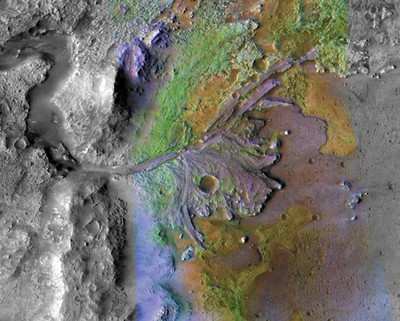Planet Was Far Different Than It Is Today
 The
Red Planet was once a very wet planet, according to new data from
NASA's Mars Reconnaissance Orbiter. Two studies based on the data
have revealed Mars once hosted vast lakes, flowing rivers and a
variety of other wet environments that had the potential to support
life.
The
Red Planet was once a very wet planet, according to new data from
NASA's Mars Reconnaissance Orbiter. Two studies based on the data
have revealed Mars once hosted vast lakes, flowing rivers and a
variety of other wet environments that had the potential to support
life.
One study, published in the July 17 issue of Nature, shows that
vast regions of the ancient highlands of Mars, which cover about
half the planet, contain clay minerals -- which can form only in
the presence of water. Volcanic lavas buried the clay-rich regions
during subsequent, drier periods of the planet's history, but
impact craters later exposed them at thousands of locations across
Mars. The data for the study derives from images taken by the
Compact Reconnaissance Imaging Spectrometer for Mars, or CRISM, and
other instruments on the orbiter.
"The big surprise from these new results is how pervasive and
long-lasting Mars' water was, and how diverse the wet environments
were," said Scott Murchie, CRISM principal investigator at the
Johns Hopkins University Applied Physics Laboratory in Laurel,
MD.
The clay-like minerals, called phyllosilicates, preserve a
record of the interaction of water with rocks dating back to what
is called the Noachian period of Mars' history, approximately 4.6
billion to 3.8 billion years ago. This period corresponds to the
earliest years of the solar system, when Earth, the moon and Mars
sustained a cosmic bombardment by comets and asteroids. Rocks of
this age have largely been destroyed on Earth by plate tectonics.
They are preserved on the moon, but were never exposed to liquid
water. The phyllosilicate-containing rocks on Mars preserve a
unique record of liquid water environments possibly suitable for
life in the early solar system.
"The minerals present in Mars' ancient crust show a variety of
wet environments," said John Mustard, a member of the CRISM team
from Brown University, and lead author of the Nature study. "In
most locations the rocks are lightly altered by liquid water, but
in a few locations they have been so altered that a great deal of
water must have flushed though the rocks and soil. This is really
exciting because we're finding dozens of sites where future
missions can land to understand if Mars was ever habitable and if
so, to look for signs of past life."
Another study, published in the June 2 issue of Nature
Geosciences, finds the wet conditions on Mars persisted for a long
time. Thousands to millions of years after the clays formed, a
system of river channels eroded them out of the highlands and
concentrated them in a delta where the river emptied into a crater
lake slightly larger than California's Lake Tahoe, approximately 40
kilometers (25 miles) in diameter.
"The distribution of clays inside the ancient lakebed shows that
standing water must have persisted for thousands of years," says
Bethany Ehlmann, another member of the CRISM team from Brown.
Ehlmann is lead author of the study of an ancient lake within a
northern-Mars impact basin called Jezero Crater. "Clays are
wonderful at trapping and preserving organic matter, so if life
ever existed in this region, there's a chance of its chemistry
being preserved in the delta."
CRISM's high spatial and spectral resolutions are better than
any previous spectrometer sent to Mars and reveal variations in the
types and composition of the phyllosilicate minerals. By combining
data from CRISM and the orbiter's Context Imager and High
Resolution Imaging Science Experiment, the team identified three
principal classes of water-related minerals dating to the early
Noachian period. The classes are aluminum-phyllosilicates, hydrated
silica or opal, and the more common and widespread
iron/magnesium-phyllosilicates. The variations in the minerals
suggest that different processes, or different types of watery
environments, created them.

"Our whole team is turning our findings into a list of sites
where future missions could land to look for organic chemistry and
perhaps determine whether life ever existed on Mars," said
Murchie.
 ANN's Daily Aero-Term (04.14.24): Maximum Authorized Altitude
ANN's Daily Aero-Term (04.14.24): Maximum Authorized Altitude ANN's Daily Aero-Linx (04.14.24)
ANN's Daily Aero-Linx (04.14.24) Classic Aero-TV: 'We're Surviving'-- Kyle Franklin Describes Airshow Life 2013
Classic Aero-TV: 'We're Surviving'-- Kyle Franklin Describes Airshow Life 2013 Aero-News: Quote of the Day (04.14.24)
Aero-News: Quote of the Day (04.14.24) Airborne 04.09.24: SnF24!, Piper-DeltaHawk!, Fisher Update, Junkers
Airborne 04.09.24: SnF24!, Piper-DeltaHawk!, Fisher Update, Junkers




